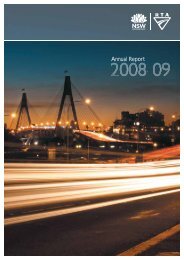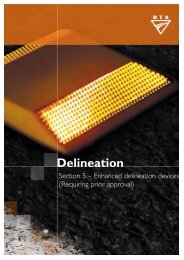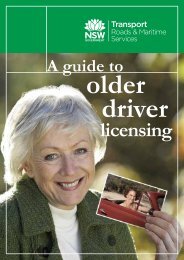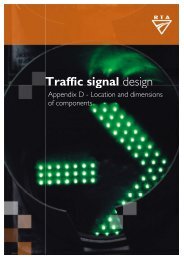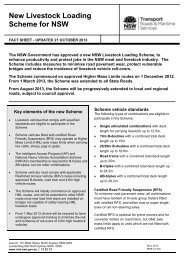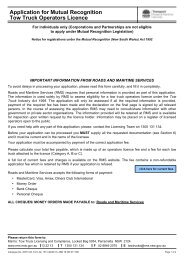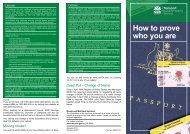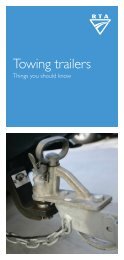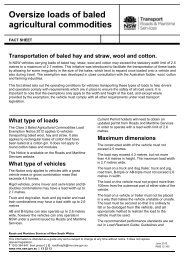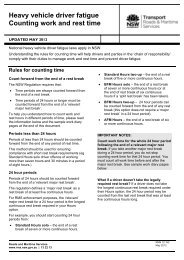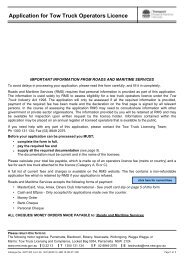Annual Report 2006 (main body) - RTA - NSW Government
Annual Report 2006 (main body) - RTA - NSW Government
Annual Report 2006 (main body) - RTA - NSW Government
Create successful ePaper yourself
Turn your PDF publications into a flip-book with our unique Google optimized e-Paper software.
(ABOVE) Some of the team members that were<br />
involved in the delivery of the Westlink M7.<br />
(LEFT) <strong>RTA</strong> employee Jim Papaioannou, splices steel<br />
rope in the workshop of the Sydney Harbour Bridge<br />
<strong>main</strong>tenance crew.<br />
Development of a fraud risk<br />
management plan.<br />
Finalising the implementation<br />
of a corruption risk assurance<br />
program to strengthen the direct<br />
control of corruption risks by<br />
<strong>RTA</strong> line management.<br />
Conducting seminars with new and<br />
existing staff as part of induction and<br />
at other appropriate times.These<br />
seminars reinforce the corruptionresistant<br />
culture of the <strong>RTA</strong>.<br />
The provision of corruption<br />
prevention information through<br />
the <strong>RTA</strong>’s intranet and quarterly<br />
updates to staff.<br />
Providing advice to staff and<br />
management on a broad range<br />
of corruption risk, ethical, probity<br />
and policy issues.<br />
Strategic and business risk<br />
The <strong>RTA</strong> is well advanced in the<br />
implementation of a risk management<br />
process to establish a consistent and<br />
whole of <strong>RTA</strong> approach to business and<br />
strategic risk identification, assessment,<br />
management and reporting. The process<br />
aims to provide formal assurance to the<br />
Executive and the Audit and Risk<br />
Committee that risks are being effectively<br />
managed. Once established, the Executive<br />
meetings will include regular reports on<br />
the Corporate Risk Profile of the<br />
organisation’s most critical risks.<br />
Code of conduct and ethics<br />
The <strong>RTA</strong> continues to work diligently towards<br />
ensuring a workplace free of harassment,<br />
discrimination or workplace bullying.<br />
Throughout 2005–06, the <strong>RTA</strong> conducted 55<br />
Harassment Discrimination and Workplace<br />
Bullying Prevention Workshops, attended<br />
by over 1,000 staff.The workshops, in both<br />
metropolitan and regional areas and across<br />
directorates, inform staff of how to define,<br />
manage and prevent such conduct.<br />
The <strong>RTA</strong> is also committed to resolving<br />
disputes in the workplace with a Grievance<br />
Network program. In 2005–06, the<br />
<strong>RTA</strong> conducted 47 Grievance Resolution<br />
Workshops attended by over 700 staff<br />
across <strong>NSW</strong>. These workshops provide<br />
staff with the skills to be able to resolve<br />
interpersonal differences and workplace<br />
difficulties as they arise. Feedback about<br />
both workshops has been very positive.<br />
OUR STAFF<br />
EMPLOYMENT STATUS<br />
Within the <strong>RTA</strong>’s diverse operations and<br />
services about 47 per cent of staff are<br />
employed in country locations; one third of<br />
regional employees are wages staff and two<br />
third are salaried staff. Many <strong>RTA</strong> motor<br />
registry and call centre employees are<br />
engaged in permanent part-time work. For<br />
more information about the <strong>RTA</strong>’s staff<br />
numbers and status, see Table 11 or<br />
Appendix 6.<br />
Leadership survey<br />
During the year, the <strong>RTA</strong> conducted a survey<br />
with staff with salaries of USS 7 to Senior<br />
Officer 3 (plus Graduates). The <strong>main</strong><br />
objectives were to profile this group,<br />
determine what staff intended to do in<br />
the next five years and determine what<br />
key capabilities, skills and professional<br />
development activities should be offered to<br />
potential leaders. Approximately threequarters<br />
of those invited participated in the<br />
survey (the vast majority online), resulting in<br />
an overall sample size of 2011.<br />
The survey showed that:<br />
Around one in three staff surveyed<br />
are over 50 years of age.<br />
The staff are well-educated particularly<br />
in the younger age groups.<br />
Many staff have held a number<br />
of different positions within the <strong>RTA</strong><br />
and there are also many who have<br />
worked in the private sector.<br />
Generally staff are satisfied and<br />
comfortable with challenges.<br />
Half of the survey group already<br />
have some line management<br />
responsibilities and/or project<br />
management experience. Many are<br />
currently or have in the past been on<br />
secondment or acted in roles.Two in<br />
five have applied for more senior roles<br />
in the past three years.<br />
Sixteen per cent of staff surveyed<br />
expect to retire in the next five years<br />
with the vast majority of the re<strong>main</strong>der<br />
expecting to be working at the <strong>RTA</strong>.<br />
66 VALUE FOR MONEY



